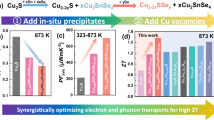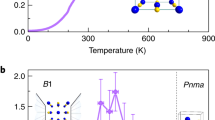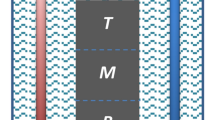Abstract
The liquid-like feature of thermoelectric superionic conductors is a double-edged sword: the long-range migration of ions hinders the phonon transport, but their directional segregation greatly impairs the service stability. We report the synergetic enhancement in figure of merit (ZT) and stability in Cu1.99Se-based superionic conductors enabled by ion confinement effects. Guided by density functional theory and nudged elastic band simulations, we elevated the activation energy to restrict ion migrations through a cation–anion co-doping strategy. We reduced the carrier concentration without sacrificing the low thermal conductivity, obtaining a ZT of ∼3.0 at 1,050 K. Notably, the fabricated device module maintained a high conversion efficiency of up to ∼13.4% for a temperature difference of 518 K without obvious degradation after 120 cycles. Our work could be generalized to develop electrically and thermally robust functional materials with ionic migration characteristics.
This is a preview of subscription content, access via your institution
Access options
Access Nature and 54 other Nature Portfolio journals
Get Nature+, our best-value online-access subscription
$29.99 / 30 days
cancel any time
Subscribe to this journal
Receive 12 print issues and online access
$259.00 per year
only $21.58 per issue
Buy this article
- Purchase on Springer Link
- Instant access to full article PDF
Prices may be subject to local taxes which are calculated during checkout




Similar content being viewed by others
Data availability
All data are available in the main text or Supplementary Information. Source data are provided with this paper.
References
Bell, L. E. Cooling, heating, generating power, and recovering waste heat with thermoelectric systems. Science 321, 1457–1461 (2008).
Tan, G., Zhao, L. D. & Kanatzidis, M. G. Rationally designing high-performance bulk thermoelectric materials. Chem. Rev. 116, 12123–12149 (2016).
Mao, J. et al. High thermoelectric cooling performance of n-type Mg3Bi2-based materials. Science 365, 495–498 (2019).
Wei, T.-R., Wu, C.-F., Li, F. & Li, J.-F. Low-cost and environmentally benign selenides as promising thermoelectric materials. J. Materiomics 4, 304–320 (2018).
Pei, Y. et al. Convergence of electronic bands for high performance bulk thermoelectrics. Nature 473, 66–69 (2011).
Zhao, W. et al. Superparamagnetic enhancement of thermoelectric performance. Nature 549, 247–251 (2017).
Biswas, K. et al. High-performance bulk thermoelectrics with all-scale hierarchical architectures. Nature 489, 414–418 (2012).
Jiang, B. et al. High-entropy-stabilized chalcogenides with high thermoelectric performance. Science 371, 830–834 (2021).
Liu, H. et al. Copper ion liquid-like thermoelectrics. Nat. Mater. 11, 422–425 (2012).
Zhang, Z. et al. Cu2Se-based liquid-like thermoelectric materials: looking back and stepping forward. Energy Environ. Sci. 13, 3307–3329 (2020).
Yang, D. et al. Blocking ion migration stabilizes the high thermoelectric performance in Cu2Se composites. Adv. Mater. 32, e2003730 (2020).
Olvera, A. A. et al. Partial indium solubility induces chemical stability and colossal thermoelectric figure of merit in Cu2Se. Energy Environ. Sci. 10, 1668–1676 (2017).
Qiu, P. et al. Suppression of atom motion and metal deposition in mixed ionic electronic conductors. Nat. Commun. 9, 2910 (2018).
Lee, J.-W., Tan, S., Seok, S. I., Yang, Y. & Park, N.-G. Rethinking the A cation in halide perovskites. Science 375, eabj1186 (2022).
Zhao, Y. et al. Suppressing ion migration in metal halide perovskite via interstitial doping with a trace amount of multivalent cations. Nat. Mater. 21, 1396–1402 (2022).
Nazrul Islam, S. M. K. et al. Copper diffusion rates and hopping pathways in superionic Cu2Se. Acta Mater. 215, 117026 (2021).
Gao, Y. et al. Classical and emerging characterization techniques for investigation of ion transport mechanisms in crystalline fast ionic conductors. Chem. Rev. 120, 5954–6008 (2020).
Liu, W. et al. Ag doping induced abnormal lattice thermal conductivity in Cu2Se. J. Mater. Chem. C 6, 13225–13231 (2018).
Zhao, K. et al. Enhanced thermoelectric performance through tuning bonding energy in Cu2Se1–xSx liquid-like materials. Chem. Mater. 29, 6367–6377 (2017).
Day, T. W. et al. Influence of compensating defect formation on the doping efficiency and thermoelectric properties of Cu2-ySe1–xBrx. Chem. Mater. 27, 7018–7027 (2015).
Bailey, T. P. et al. Enhanced ZT and attempts to chemically stabilize Cu2Se via Sn doping. J. Mater. Chem. A 4, 17225–17235 (2016).
Yang, L. et al. Te-doped Cu2Se nanoplates with a high average thermoelectric figure of merit. J. Mater. Chem. A 4, 9213–9219 (2016).
Jin, Z. et al. Thermoelectric properties and service stability of Ag-containing Cu2Se. Mater. Today Phys. 21, 100550 (2021).
Nazrul Islam, S. M. K. et al. Giant enhancement of the figure-of-merit over a broad temperature range in nano-boron incorporated Cu2Se. J. Mater. Chem. A 6, 18409–18416 (2018).
Lei, J. et al. High thermoelectric performance in Cu2Se superionic conductor with enhanced liquid-like behaviour by dispersing SiC. J. Mater. Chem. A 7, 7006–7014 (2019).
Nunna, R. et al. Ultrahigh thermoelectric performance in Cu2Se-based hybrid materials with highly dispersed molecular CNTs. Energy Environ. Sci. 10, 1928–1935 (2017).
Hu, X. et al. Power generation from nanostructured PbTe-based thermoelectrics: comprehensive development from materials to modules. Energy Environ. Sci. 9, 517–529 (2016).
Jiang, B. et al. Realizing high-efficiency power generation in low-cost PbS-based thermoelectric materials. Energy Environ. Sci. 13, 579–591 (2020).
Xing, T. et al. High efficiency GeTe-based materials and modules for thermoelectric power generation. Energy Environ. Sci. 14, 995–1003 (2021).
Zhang, Q. et al. Realizing high-performance thermoelectric power generation through grain boundary engineering of skutterudite-based nanocomposites. Nano Energy 41, 501–510 (2017).
Nie, G. et al. High performance thermoelectric module through isotype bulk heterojunction engineering of skutterudite materials. Nano Energy 66, 104193 (2019).
Chu, J. et al. Electrode interface optimization advances conversion efficiency and stability of thermoelectric devices. Nat. Commun. 11, 2723 (2020).
Yu, J. et al. Half-Heusler thermoelectric module with high conversion efficiency and high power density. Adv. Energy Mater. 10, 2000888 (2020).
Xing, Y. et al. A device-to-material strategy guiding the ‘double-high’ thermoelectric module. Joule 4, 2475–2483 (2020).
Fu, Y. et al. Mg3(Bi,Sb)2-based thermoelectric modules for efficient and reliable waste-heat utilization up to 750 K. Energy Environ. Sci. 15, 3265–3274 (2022).
Bu, Z. et al. An over 10% module efficiency obtained using non-Bi2Te3 thermoelectric materials for recovering heat of <600 K. Energy Environ. Sci. 14, 6506–6513 (2021).
Ying, P. et al. Towards tellurium-free thermoelectric modules for power generation from low-grade heat. Nat. Commun. 12, 1121 (2021).
Bu, Z. et al. A record thermoelectric efficiency in tellurium-free modules for low-grade waste heat recovery. Nat. Commun. 13, 237 (2022).
Qiu, P. et al. High-efficiency and stable thermoelectric module based on liquid-like materials. Joule 3, 1538–1548 (2019).
Li, F. et al. Giant piezoelectricity of Sm-doped Pb (Mg1/3Nb2/3)O3–PbTiO3 single crystals. Science 364, 264–268 (2019).
Zhu, Y., Zhou, W., Sunarso, J., Zhong, Y. & Shao, Z. Phosphorus-doped perovskite oxide as highly efficient water oxidation electrocatalyst in alkaline solution. Adv. Funct. Mater. 26, 5862–5872 (2016).
Yang, T. et al. One-stone-for-two-birds strategy to attain beyond 25% perovskite solar cells. Nat. Commun. 14, 839 (2023).
Gahtori, B. et al. Giant enhancement in thermoelectric performance of copper selenide by incorporation of different nanoscale dimensional defect features. Nano Energy 13, 36–46 (2015).
Dong, J. et al. Medium-temperature thermoelectric GeTe: vacancy suppression and band structure engineering leading to high performance. Energy Environ. Sci. 12, 1396–1403 (2019).
Yu, B. et al. Thermoelectric properties of copper selenide with ordered selenium layer and disordered copper layer. Nano Energy 1, 472–478 (2012).
Kresse, G. & Hafner, J. Ab initio molecular dynamics for liquid metals. Phys. Rev. B 47, 558–561 (1993).
Henkelman, G. & Jónsson, H. Improved tangent estimate in the nudged elastic band method for finding minimum energy paths and saddle points. J. Chem. Phys. 113, 9978–9985 (2000).
Dudarev, S. L. et al. Electron-energy-loss spectra and the structural stability of nickel oxide: an LSDA + U study. Phys. Rev. B 57, 1505–1509 (1998).
Momma, K. & Izumi, F. VESTA 3 for three-dimensional visualization of crystal, volumetric and morphology data. J. Appl. Crystallogr. 44, 1272–1276 (2011).
Acknowledgements
This work was supported by a Basic Science Center Project of the National Natural Science Foundation of China (52388201) and the National Key R&D Program of China (2023YFB3809400). J.Y. gratefully acknowledges financial support from the International Postdoctoral Exchange Fellowship Program (Talent-Introduction Program) (YJ20220135) and Shuimu Tsinghua Scholar Program.
Author information
Authors and Affiliations
Contributions
H.H., J.Y. and J.-F.L. designed this work. H.H. prepared the samples and carried out the thermoelectric property measurements. Y. Ju, Z.W., H.Z. and J.Z. conducted the STEM observations and analysis. J.P., H.-C.T., Z.H. and B.-P.Z. carried out the DFT calculations. H.H. and J.Y. carried out the stability test. H.H., J.-W.L., B.C., F.L., H.-L.Z. and B.S. built the thermoelectric devices and performed the energy conversion efficiency measurements. H.-L.Z., B.S., H.L. and Q.L. provided helpful discussions. H.H. and Y. Jiang carried out the Hall measurements. All authors conceived the experiments, analysed the results and co-edited the manuscript.
Corresponding authors
Ethics declarations
Competing interests
The authors declare no competing interests.
Peer review
Peer review information
Nature Materials thanks Pengfei Qiu and the other, anonymous, reviewer(s) for their contribution to the peer review of this work.
Additional information
Publisher’s note Springer Nature remains neutral with regard to jurisdictional claims in published maps and institutional affiliations.
Supplementary information
Supplementary Information
Supplementary Note, Figs. 1–21, Tables 1–3 and refs. 1 and 2.
Supplementary Data 1
Atomic coordinates of the computational models.
Source data
Source Data Fig. 1
Source data for Fig. 1a–c.
Source Data Fig. 2
Source data for Fig. 2c,f,g–i.
Source Data Fig. 3
Source data for Fig. 3a–d.
Source Data Fig. 4
Source data for Fig. 4a,b,e–j.
Rights and permissions
Springer Nature or its licensor (e.g. a society or other partner) holds exclusive rights to this article under a publishing agreement with the author(s) or other rightsholder(s); author self-archiving of the accepted manuscript version of this article is solely governed by the terms of such publishing agreement and applicable law.
About this article
Cite this article
Hu, H., Ju, Y., Yu, J. et al. Highly stabilized and efficient thermoelectric copper selenide. Nat. Mater. 23, 527–534 (2024). https://doi.org/10.1038/s41563-024-01815-1
Received:
Accepted:
Published:
Issue Date:
DOI: https://doi.org/10.1038/s41563-024-01815-1
This article is cited by
-
Thermoelectric copper selenide gets a boost
Nature Reviews Materials (2024)
-
Mobile ion confinement for better thermoelectrics
Nature Materials (2024)



